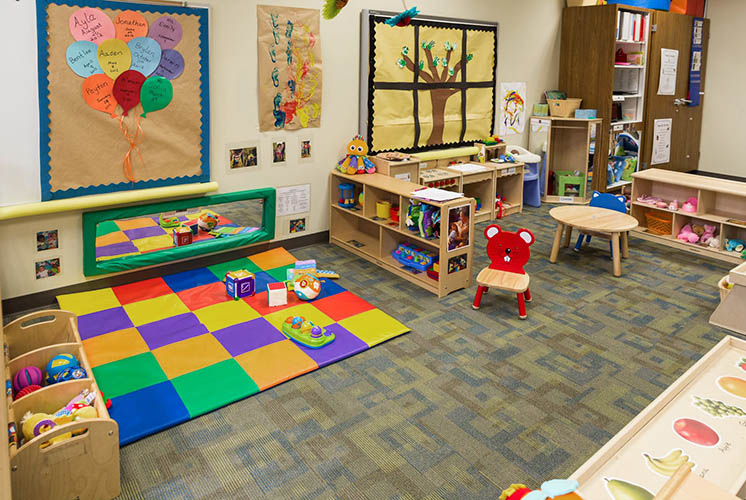
The Head Start Program Performance Standards (HSPPS) provide a framework for planning the design of developmentally appropriate classroom and socialization environments for infants and toddlers. They offer guidance around:
- Square footage requirements
- Teaching and learning environments
- Group socialization
- Safety practices for facilities, equipment, and materials
Each program is responsible for creating environments that meet the needs of the children and adults who will use them.
Some programs need to construct a new building that includes spaces for infants and toddlers. Others need to renovate or retrofit spaces (e.g., turning a preschool classroom into an infant, toddler, or mixed-age classroom) or upgrade spaces (e.g., repainting and reorganizing an infant and toddler socialization space). Regardless of the extent of the work, as programs plan, they should consider issues such as:
Every Head Start infant and toddler classroom must be designed to provide a safe, developmentally appropriate environment. Home-based socialization spaces need to follow a similar design process to ensure an optimal environment for daily routines and learning.
- Budget
- Environmental and community assessments
- Internal and external collaborators
- Health and safety monitoring
- Staffing
- Training
The strategies below are organized into two sections: Building and Facility, and Learning Environments. Programs can use these strategies to effectively design developmentally appropriate environments for infants and toddlers.
Strategies
Building and Facility Planning Tips
Ensure space meets or exceeds HSPPS about usable space for routine care, learning experiences, and supervision—or state or local regulations, if those are more stringent than the HSPPS.
- Consider using a team approach to design environments. Include staff with knowledge and experience in project management, finance, health and safety, and infant and toddler development and learning. Refer to the Head Start Management Systems Wheel to address all relevant systems.
- Allocate adequate resources to designing spaces, including funds for:
- Plumbing
- Flooring
- Storage (e.g., diapering supplies, extra clothes, car seats, strollers)
- Lighting
- Meeting fire codes
- Consult with local building and licensing departments to meet health and safety regulations.
- Collaborate with community partners in child care and licensing to maximize their resources.
- Consider working with an architect who has experience designing spaces for infants and toddlers. As appropriate for the program option, design developmentally appropriate outdoor spaces. For new buildings, consider space for staff breaks and planning.
- When possible, engage parents and staff in the design process, most importantly during the initial planning stages.
- Consider accessibility for infants, toddlers, and adults with disabilities to ensure the space meets the American with Disabilities (ADA) requirements.
- Develop a plan to train staff about facilities requirements, relevant HSPPS, and local licensing regulations.
Programs can also benefit from using the following resources as they design infant and toddler environments that involve construction or renovations:
- Facility Purchase, Construction, or Major Renovation Using Head Start Grant Funds
Learning Environments Planning Tips
Programs may divide a shared space to accommodate two groups of children. The division should ensure autonomy and separation of the two groups, with a minimum of distractions and noise between the groups. The Head Start Design Guide suggests that "solid or glazed partitions at full height, doors, casework, cabinets, panels, and railings can be used for separation" and that "three types of separation must be considered: acoustical [sound], visual, and physical" (78– 79).
- Ensure group size and adult-child ratios in the space are consistent with HSPPS or state regulations, whichever is most stringent. Consider using mixed-age groups to support continuity of care in centers.
- Consider ways to lower noise levels and provide natural and nonflorescent lighting. Arrange safe traffic patterns so children and adults can easily access all areas of the room.
- Make sure the environmental layout, including traffic patterns and designated learning or activity areas, supports positive interactions among children and between children and adults. Provide enough space for nonmobile infants, infants who are becoming mobile, and toddlers to explore safely.
- Pay attention to the potential for spaces to be over-stimulating for infants and toddlers. To avoid making excessive demands on their self-regulation and coping skills, consider the amount of noise, light, and movement of people in the space.
- Ensure handwashing and toileting areas for children are child-sized, diapering areas are next to an adult-level sink, and food prep areas with sinks are located away from diapering and toileting areas. Well-designed routine care spaces help staff use the experiences effectively to support infants' and toddlers' learning.
- Provide accommodations, as necessary, for mothers who wish to breastfeed during program hours.
- Include cozy spaces for quiet play where children can be alone or with one or two other children while still being easily supervised by sight and sound.
- Create a play and learning space that is separate from the crib area. Note that Caring for Our Children (CFOC) 5.4.5.1: Sleeping Equipment and Supplies recommends placing cribs at least 3 feet apart.
- Ensure there is a separate crib for each infant (or cot for toddlers) to accommodate individual sleep schedules and ensure a safe, comfortable napping experience.
- No child should simultaneously share a crib or cot with another child. If cribs or cots are used by different children, they should be cleaned between uses. See CFOC 5.4.5.1: Sleeping Equipment and Supplies for more information.
- Design spaces with cozy areas and furnishings that make it easy for adults to sit comfortably with children (e.g., during bottle feeding, shared book reading, and other one-on-one interactions).
- Consult the infant and toddler curriculum for additional guidance and recommendations about organizing the space. Consider how placement of equipment, furniture, toys, and other materials support infants' and toddlers' development and learning. Include guidance and recommendations for outdoor spaces, as appropriate to the program option.
- Engage in ongoing monitoring to ensure the environmental design is effective for children and adults.
Head Start Program Performance Standards

Center-based option, 45 CFR §1302.21:
- (d) Licensing and square footage requirements
Home-based option, 45 CFR §1302.22:
- (d) Safety requirements
Teaching and the learning environment, 45 CFR §1302.31:
- (c)(1) Learning environment
- (d) Materials and space for learning
- (e) Promoting learning through approaches to rest, meals, routines, and physical activity
Education in home-based programs, 45 CFR §1302.35:
- (e)(1) Group socialization
Child nutrition, 45 CFR §1302.44:
- (a)(2)(viii) Nutrition service requirements (promote breastfeeding)
Safety practices, 45 CFR §1302.47:
- (b)(1) Facilities
- (b)(2) Equipment and materials
Full participation in program services and activities, 45 CFR §1302.60
Additional services for children, 45 CFR §1302.61
Resources
- New construction, 45 CFR §84.23 (nondiscrimination on the basis of handicap in programs or activities receiving federal financial assistance)
- Accessibility Standards for Facilities
- Caring for Our Children (CFOC)
- Child Care Providers: Your Guide to New Crib Standards
- Socialization Environments in Head Start Home-based Programs
- Tips for Keeping Children Safe: A Developmental Guide
« Go to Head Start Tip Sheets for Grantee Planning
Read more:
Resource Type: Article
National Centers: Early Childhood Development, Teaching and Learning
Last Updated: February 19, 2025


